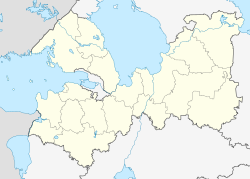Krasny Bor (Leningrad)
| Urban-type settlement
Krasny Bor
Красный Бор
|
||||||||||||||||||||||||||
|
||||||||||||||||||||||||||
|
||||||||||||||||||||||||||
Krasny Bor ( Russian Кра́сный Бор , literally Red Coniferous Forest or Beautiful Coniferous Forest , depending on the interpretation) is an urban-type settlement in Leningrad Oblast in Russia , 20 km southeast of Saint Petersburg . It has 5033 inhabitants (as of October 14, 2010).
Krasny Bor is located on the St. Petersburg – Moscow railway line (also known as the Nikolaibahn) immediately southeast of the city of Kolpino and has a station called Popowka at it .
history
The current settlement emerged in the 1930s from the two villages Podobedowka and Popowka , the latter being reminiscent of the name of the local train station to this day. After the completion of the Kolpino – Tschudowo section of the Nikolaibahn running through Popowka in 1849, Popowka developed into a station settlement in the late 19th century, and several striking church buildings were erected there and in neighboring villages at the turn of the century. In addition, the area became very popular as a dacha suburb of Saint Petersburg, which brought its prosperity and a well-developed infrastructure (including its own theater) for the time. People who lived and worked in Popovka included boy scouts and the Supreme Pioneer of the Soviet pioneer organization Innokenti Zhukov and poet Nikolai Gumiljow .
In the 1930s, all churches in and around Popowka were closed by the Soviet rulers. At the same time began to develop the villages into a settlement, which was then also named Krasny Bor and in 1935 received the status of an urban settlement.
During the Second World War , Popovka was captured by the German Wehrmacht for months during the Leningrad blockade . At that time, all local churches as well as the rest of the place were destroyed. In 1943 the battle of Krasny Bor took place in the area of the settlement . After the war, Krasny Bor was largely rebuilt, but the destroyed churches were not restored. Only in 2001 was one of the old wooden churches rebuilt with donations from the faithful and consecrated to the Orthodox Saint Paraskewa.
Others
In the vicinity of Krasny Bor there is a large transmitter for long, medium and short wave, the radio station Krasny Bor . 2 km north of Krasny Bor is the largest hazardous waste dump in northwestern Russia called Krasny Bor . It is the only collection point for hazardous waste for the city of Saint Petersburg .
Population development
| 1926 | 1939 | 1949 | 1959 | 1970 | 1979 | 1989 | 2002 | 2010 |
|---|---|---|---|---|---|---|---|---|
| 3623 | 12136 | 895 | 7551 | 8189 | 7585 | 5791 | 4877 | 5033 |
photos
All photos are from the beginning of the 20th century:
Alexander Nevsky Church
Individual evidence
- ↑ a b Itogi Vserossijskoj perepisi naselenija 2010 goda. Tom 1. Čislennostʹ i razmeščenie naselenija (Results of the All-Russian Census 2010. Volume 1. Number and distribution of the population). Tables 5 , pp. 12-209; 11 , pp. 312–979 (download from the website of the Federal Service for State Statistics of the Russian Federation)
- ↑ European Bank for Reconstruction and Development - Annual Review ( Memento of the original of July 13, 2007 in the Internet Archive ) Info: The archive link has been inserted automatically and has not yet been checked. Please check the original and archive link according to the instructions and then remove this notice. , P. 59. (PDF, 4.06 MB)
Web links
- On the story of Krasny Bor (Russian)





